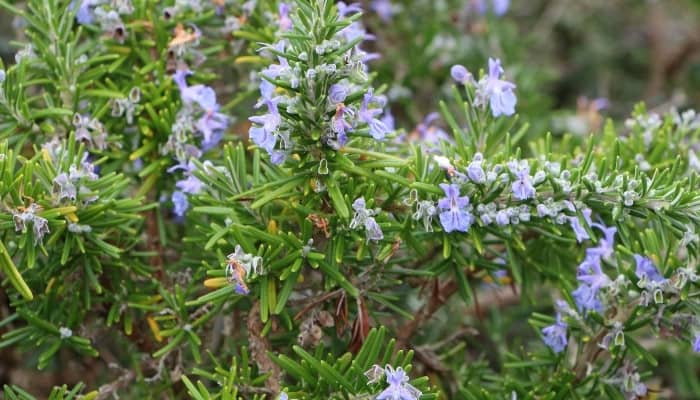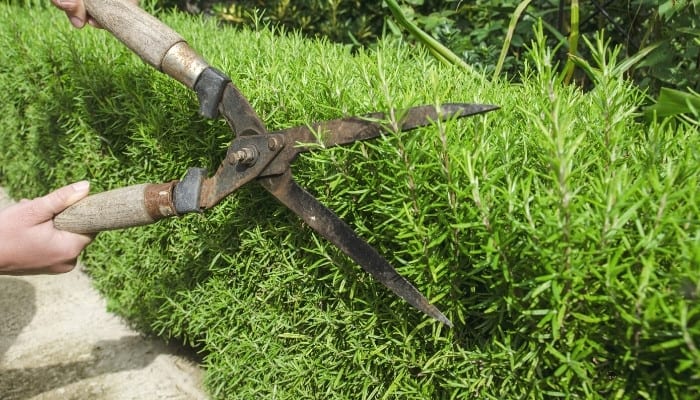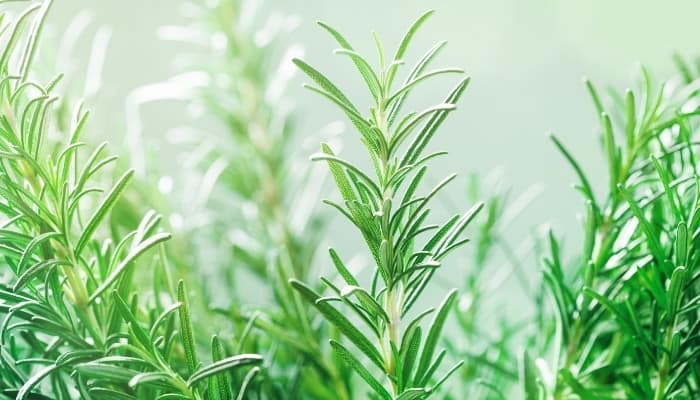Rosmarinus officinalis, a herb commonly known as rosemary, is native to the Mediterranean region and used in cooking.
Commonly known as rosemary, this plant is herbaceous and fragrant.
However, it is also known for its use in medicine and is no stranger to the wide range of condiments found in every kitchen today.
How long do rosemary plants live? Rosemary can live for more than 10 years in ideal conditions, which include warm, dry air; well-drained, slightly acidic, loamy soil; and lots of sun. Causes of early death include overwatering, insufficient sunlight, pests, poor fertilization and pruning, mildew, root rot, and incorrect climate.
To keep your rosemary plant thriving and to ensure you always have a sprig ready to add to your next culinary masterpiece, there are simple care guidelines you should follow.
Read on to find out how to protect your evergreen shrub from fading away before its time.
Rosemary Plants: Lifespan & Contributing Factors
Plant lovers the world over appreciate rosemary for its long lifespan.
If you’re struggling to keep yours going for 5 or 10 years and beyond, it’s time to learn about the factors that contribute to its lifespan.
Rosemary Lifespan Under Ideal Conditions
Being an evergreen shrub, rosemary can survive for many years in ideal conditions. The average lifespan is 10 years, but some plants can go on for 15 to 20 years!
These conditions include:
- Warm climates.
- Seldom watering your plant (watering rosemary every two weeks is ideal).
- Plenty of direct sunlight (at least 6 to 8 hours).
- Well-drained, loamy soil without rocks, weeds, and plant debris.
- Protection in winter.
- Pruning from time to time.
Life Expectancy for Potted Rosemary Plants
Potted rosemary can survive for several years. However, to keep your plant thriving, you need to evaluate its size and roots every spring.
By repotting rosemary in new soil every spring, you can increase its expected lifespan.
Common Rosemary Plant Problems That Cause Early Death

The thick leaves and hardy nature of rosemary may cause you to think that it’s impervious to sickness and disease.
Yet, when you find that your plant is browning, looking spindly, and losing its fragrant scent, it’s time to perform some troubleshooting techniques.
Since this plant is native to the Mediterranean, imitating this kind of climate will help prevent it from an early death.
Let’s look at the most common problems your rosemary may face and solutions to combat these problems.
Watering Issues
Rosemary is sensitive to overwatering. Overwatering results in foliage that droops and turns brown or yellow.
Rosemary plants demand well-draining soil. If the soil is slow-draining soil, the water will suffocate the plant’s roots, causing discoloration in the foliage.
Solution
If your rosemary is showing signs of overwatering, it’s time to scale back on watering.
Many newbie gardeners are unaware that this plant thrives best on a little bit of neglect. A little water once a week is fine.
Insufficient Sunlight
Insufficient sunlight is a common reason for weak and dying rosemary. Rosemary plants requires at least 6-8 hours of sunlight per day.
Solution
If you need to move your rosemary from its usual sunny spot, prevent light starvation by gradually moving rosemary to shadier parts.
This forces the plant to become efficient at turning light into energy.
If you have rosemary growing indoors, simulate excellent lighting conditions by placing a fluorescent light bulb close to the plant or place the plant on a sunny windowsill.
Pests
Common insects that attack weak rosemary include aphids, spider mites, mealybugs, and scale.
Aphids and Spider Mites
Aphids and spider mites suck the sap out of the plant’s leaves causing it to wilt and die.
While aphids leave a sticky substance on the leaves called honeydew, the spider mite is often overlooked because it is so tiny.
Solution
Mix a solution of essential oils such as peppermint, clove, and rosemary oil, and spray the plant regularly to get rid of aphids and spider mites.
Mealybugs
Much the same as aphids, mealybugs feed on the sap of the rosemary plant and also leave behind a sticky substance that attracts other insects.
Solution
If you notice mealybugs on your rosemary, you can spray the plant with water, neem oil (I use this organic neem on my edibles), or a soap-based insecticide.
Scales
Scales are brown and bumpy insects that leave sticky residue on plants while feeding on the plant’s sap.
Solution
Clip off and discard infested tips of rosemary. If their numbers are low, you can pick off scales by hand or dab pests with an alcohol-soaked cotton swab.
Improper Fertilization
Incorrectly fertilizing your plant will damage it, so always read the fertilizer’s instructions carefully.
Applying fertilizer directly to the plant will cause leaf burning, while using too much of a nitrogen-heavy fertilizer may attract insects that suck plant sap – also an issue.
Solution
By fertilizing the potting soil and not the leaves themselves, you can avoid foliar burning.
Rosemary seldom requires fertilizer. However, if you feel your plant’s growth is slow, apply an all-purpose fertilizer once in early spring before new growth appears.
I always have good results with this gentle yet effective organic plant food.
Diseases
Rosemary resists most diseases but is known to sometimes fall victim to powdery mildew and root rot.
Powdery Mildew
Powdery mildew is a common disease that may spread on leaves, leaving whitish spores all over the plant.
This disease occurs when the plant is in a semi-shaded area or if the soil surrounding your plant is consistently damp.
Solution
Increase air circulation around your plant or treat it with a fungicide, like this one approved for organic gardens.
To make your own fungicide, mix 1 teaspoon of baking soda with 2 liters of lukewarm water. Spray this on the plant’s leaves.
Root Rot
Root rot is a fungal disease that occurs when there is too much moisture. Root rot is common during winter periods, where there is much rainfall and less evaporation.
Solution
Immediately stop watering and remove moisture-retentive matter. If brown foliage is extensive, inspect the plant’s roots by lifting it out of the ground (or pot).
Trim dark and slimy roots, and dust with fungicide powder before replanting in fresh soil.
Cold Temperatures
Harsh winter winds and cold temperatures affect rosemary. Foliage will look spindly, short and less bushy in these conditions.
This plant can handle light frost for short periods, but freezing temperatures below 15 to 20°F (-6 to -9°C) will kill rosemary.
Solution
A plant cover can help rosemary survive a mild winter. Keeping it in a pot and bringing it indoors for winter may help your plant survive.
Too Much Humidity
Rosemary plants do not respond well to excessive humidity since they grow best in drier conditions.
Too much humidity will not only increase pest infestations, but the plant will wilt, rot, and ultimately die.
Solution
To keep pest infestations and root rot away, keep rosemary plants in a well-ventilated area with full sun. Pick a sunny, good-draining location.
It’s also a good idea to keep a fan blowing on your plants for a couple of hours a day, thus protecting them from pests.
Lack of Pruning
A lack of pruning means an accumulation of deadwood.
Also, the more your plant grows, the bushier and woodier it becomes, which will hinder the sprig’s access to proper air circulation and sunlight, resulting in an unhealthy, overgrown plant.
Solution
Removing dead wood from the plant by pruning once a season, preferably early spring or even mid-fall.
In addition, a slight trim will help increase and improve airflow to the plant’s sprigs and its ability to obtain sunlight.
Too Much Pruning
You don’t need to trim these perennial plants excessively. Instead, it would be best if you pruned when you notice they are over woody and overgrown.
Too much pruning will cause the plant to collapse, and it will not be possible to rejuvenate it. Eventually, the plant will die.
Solution
You should prune rosemary to manage its size and allow it to be more productive for the following year.
Harvest no more than ¼ of the entire plant while it’s in its growing season.

Related Questions:
Is Rosemary a Perennial?
Yes, we can consider rosemary a perennial as it completes its life cycle in three or more years, but it is often also referred to as an annual plant, depending on the climate in which it is grown.
Why Is My Rosemary Turning Yellow?
Yellowing rosemary can be a sign of two things: lack of sunlight and lack of nutrients. If the young leaves are turning yellow, it’s most likely that your plant lacks iron.
If it’s the oldest leaves that are turning yellow, your plant may be lacking nitrogen, zinc, or manganese.
Why Is My Rosemary Turning Black?
Overwatering rosemary is the primary reason why tips turn black, while overhead watering will lead to dark leaf spots. Water rosemary at the base ensuring the water drains well.
Conclusion
Rosemary is an independent plant that can faithfully serve you for several years. Improper care and inappropriate harsh conditions can lead to this plant’s premature death.
Brushing up on your rosemary care knowledge before you get a rosemary plant is the best way to ensure your plant is with you for many years to come.

